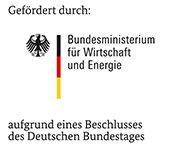459 ZBG

Hochtemperaturofen in Betrieb
| Laufzeit: | 01.12.2012 - 30.11.2014 |
|---|---|
| Geldgeber: | Bundesministerium für Wirtschaft und Energie (BMWi) über AiF |
| Bearbeiter: | Dr. Alexander Donchev |
| Arbeitsgruppe: | Hochtemperaturwerkstoffe |
Titanium is a widely used material due to its properties. It belongs to the light weight materials with a specific weight of 4.5 mg/cm3, which is much lower than that of steels or Ni-based alloys. Ti forms a passive rutile layer (TiO2) in oxidising environments which is protective at ambient temperatures. TiO2 gets deteriorated at higher temperatures (>600°C) and loses its protective barrier effect. Hence, the oxygen inward diffusion becomes the rate determining step and oxygen is enriched in the subsurface zone. This causes embrittlement which leads to failure of Ti components under cycling conditions (mechanical and thermal). Orthorhombic Ti2AlNb alloys and the α2-phase Ti3Al suffer from the same problems. Despite their Al content of about 25 at.% no protective alumina layer is formed. A mixed fast growing scale develops instead. Furthermore a high amount of oxygen can be solved in the subsurface zones of the phases (more than 20%). These materials cannot be used for high temperature applications.
To overcome such problems the surfaces of Ti or Ti2AlNb compounds have to be modified. The single Al enrichment of the surface by coatings has been reported in the literature already, but this attempt was only slightly beneficial. The combined Al enrichment plus additional fluorine treatment proved to be much more beneficial which was shown in two finished projects (F508, F508F). The fluorine effect known from TiAl alloys with an Al content above 40 at.% was transferred to Ti alloys with a much lower Al content. The formation of an Al2O3 scale is promoted by a defined amount of fluorine (fluorine effect) and this layer is protective against environmental attack even under thermocyclic conditions and prevents oxygen diffusion into the substrate. The parameters for the Al enrichment have to be optimised. This will be done at DFI and afterwards such treated samples will be fluorine-implanted at Helmholtzzentrum Dresden-Rossendorf (HZDR) via plasma-immersion-ion-implantation (PI3). The depth profiles will be determined at HZDR. The investigations of the corrosion behaviour will be performed at DFI. The effect of the treatment on the mechanical properties will be measured at DFI, too.
zurück
Das IGF-Vorhaben Nr. 459 ZBG der Forschungsvereinigung DECHEMA e.V., Theodor-Heuss-Allee 25, 60486 Frankfurt am Main wurde über die AiF im Rahmen des Programms zur Förderung der industriellen Gemeinschaftsforschung (IGF) vom Bundesministerium für Wirtschaft und Energie aufgrund eines Beschlusses des Deutschen Bundestages gefördert.
Dr. Alexander Donchev
Tel.: 069 / 7564-386
E-Mail: alexander.donchev
A. Donchev, J. Grüters, M.C. Galetz, M. Schütze, Advances in Materials and Processing Technologies 2 (2016), 471
Abschlussbericht (pdf, 6,1 MB)